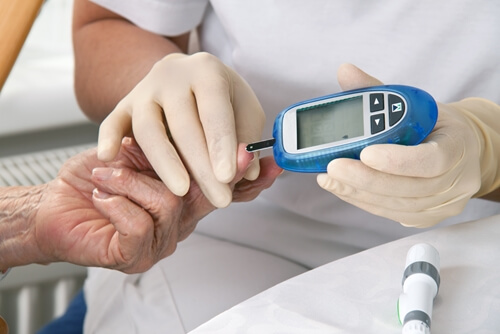Important: We updated this article in January 2023 to reflect current Social Security Administration policy data. Diabetes mellitus describes a group of diseases that affect how your body uses glucose, or blood sugar (an important energy source for cells and your brain). Individuals with diabetes have too much glucose in their blood, which can lead to serious health problems. These diabetes complications may make you able to receive Social Security disability (SSD) benefits. Keep reading to learn more about getting Social Security benefits for diabetes.
Types Of Chronic Diabetes: Type 1 and Type 2
Type 1 Diabetes
Type 1 diabetes, also known as juvenile diabetes, often develops in children. However, it can also occur once you’re an adult. In Type 1, one of two things will happen. Option 1 is that your body stops making insulin at all. Option 2 is that your body doesn’t produce enough because your immune system destroys the cells that make insulin.
Treatment for Type 1 often includes:
- Insulin shots.
- Oral medications.
- Healthy eating.
- Exercise.
- Controlling blood pressure.
Type 2 Diabetes
Type 2 diabetes is referred to as adult-onset, but it can affect a person at any age. Inactive and obese people are at particular risk for Type 2. Type 2 diabetes starts with insulin resistance, causing the body to need more insulin to move glucose into cells. Over time, the pancreas becomes unable to produce the amount of insulin your body needs. This then leads to a spike in blood sugar, especially after eating.
Treatment usually includes:
- Taking medication.
- Eating healthy.
- Regular physical activity.
- Controlling blood pressure as well as cholesterol.
Are There Social Security Benefits for Diabetes?
Do your symptoms prevent you from working 40 hours each week? Then you might qualify for Social Security benefits for diabetes. However, you must meet the Social Security Administration’s qualifications for Social Security benefits for diabetes. We will list the SSA’s medical eligibility rules below.
Social Security Benefits for Diabetes: Checking Your Eligibility
To prove you meet the rules to get Social Security benefits for diabetes, you must:
- Have uncontrolled diabetes that stops you from working at least one year. Or, your doctor says you will be unable to work for at least 12 months.
- The damage caused by your diabetes must seriously limit what work you can do.
- Your related health problems must meet the SSA’s requirements in the Blue Book listing. Know that if your illness isn’t under control because you don’t follow your doctor’s orders, the SSA will deny your claim.
- Additionally, if your diabetes causes neuropathy, issues with physical movement or diabetic retinopathy, you may qualify for Social Security disability benefits for diabetes.
If you aren’t tracking your blood sugar yet at home, you should be. We like the Care Touch glucose monitoring kit, which they’ll ship free overnight.
Is Getting Social Security Benefits for Diabetes Difficult?
While having diabetes alone isn’t enough to get benefits, that’s not your only option. If you have certain related health issues, then you may also qualify. The following conditions can be found in the Blue Book:
- Diabetic nephropathy: Kidneys no longer filter waste out of the blood properly.
- Cardiovascular disease: Coronary heart disease, irregular heartbeat, or peripheral vascular disease.
- Diabetic retinopathy: Blurred vision, poor peripheral vision or visual acuity.
- Diabetic peripheral neuropathy: Nerve damage in the hands, feet, arms or legs that makes it difficult to walk, stand, or use your hands.
- Amputation: Surgical removal of your foot, lower leg, or entire leg due to poor circulation, nerve damage, or a serious infection.
- Poorly healing skin issues: Skin ulcers that make it difficult to use your hands or walk.
If you don’t have the above related health issues, the SSA will review your medical evidence to see if it proves you cannot work. Using that information, the agency will determine how well you can use your limbs as well as your ability to stand and walk. In some cases, the SSA may request a residual functional capacity form. If so, this form measures what level of activity you can do and if you can focus and get along with others. Additionally, the SSA will review notes and results from doctors and any tests from the past 12 months. They’ll also review statements from you, your family or friends on how diabetes limits your ability to work.
You May Qualify for Legal Assistance
Navigating the application process to get Social Security benefits for diabetes can be tricky. That’s why we recommend getting professional help from a Social Security attorney. It’s free to apply on your own or with legal help. That said, only the second option improves your chances for getting benefits right away. Legal assistance makes you 3x more likely to get benefits vs. filing on your own. You’ll pay nothing unless a lawyer helps you win benefits. And if you do end up getting Social Security benefits for diabetes, you’ll only pay one small fee.
Want free expert claim help? Click the button below to sign up for a free phone call from a nearby expert during regular weekday business hours:
Get Your Free Benefits Evaluation
Lori Polemenakos is Director of Consumer Content and SEO strategist for LeadingResponse, a legal marketing company. An award-winning journalist, writer and editor based in Dallas, Texas, she's produced articles for major brands such as Match.com, Yahoo!, MSN, AOL, Xfinity, Mail.com, and edited several published books. Since 2016, she's published hundreds of articles about Social Security disability, workers' compensation, veterans' benefits, personal injury, mass tort, auto accident claims, bankruptcy, employment law and other related legal issues.

















